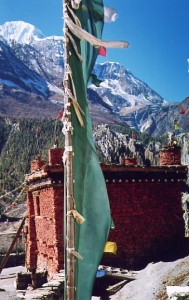 There is no one statement of beliefs (a creed). Buddhism is however based on Buddha’s teachings. At first these were passed down by word of mouth. At some stage between 250-500 years after his death two sets of scriptures were compiled, one set by Council of Monks of the Theravada school (The Tripitaka) the other by the Mahayana school. Both were similar. The latter were mostly lost when the Moslem’s invaded, but their ideas were continued in Tibetan and Chinese texts.
There is no one statement of beliefs (a creed). Buddhism is however based on Buddha’s teachings. At first these were passed down by word of mouth. At some stage between 250-500 years after his death two sets of scriptures were compiled, one set by Council of Monks of the Theravada school (The Tripitaka) the other by the Mahayana school. Both were similar. The latter were mostly lost when the Moslem’s invaded, but their ideas were continued in Tibetan and Chinese texts.
The Tripitaka (the three baskets) is in three parts and written in the Pali language, it consists of:
1. The teaching of Buddha (Dharma)
2. An explanation on that teaching (Adhidharma). Most of these are called Sutras
3. A rule book for monks and nuns (the Vinaya) There are 227 rules for monks,and more for nuns! The rules can be relaxed. Shoes were not one of the items a monk was originally allowed to have, but they are now worn. The rule book also sets out instructions on ceremonies
Studying, chanting, learning and discussing these and other texts are an important part of a Buddhist’s life.
The Prahmoksha (the heart of the Vinaya) is recited by monks and nuns when there are new and full moons.
Jatakas are part of the Tripitaka. They are hundreds of stories about Buddha’s earlier life, particularly as an animal. They are an introduction to Buddhism and to the importance of good qualities.